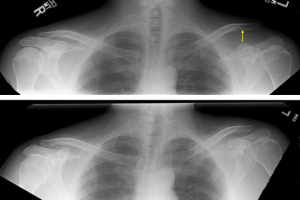AC Joint Injury Overview
Shoulder injuries of the AC joint, or acromioclavicular joint, are quite common. An AC joint injury can result from a hard fall, accident, or from a traumatic event. An acromioclavicular joint injury can result in a severe AC sprain, AC fracture or an AC joint separation, which occurs when the collarbone (clavicle) separates from the shoulder blade (acromion). An AC joint injury is measured in varying grades. For example, a Grade I injury will bring mild shoulder pain because the AC ligaments are simply stretched. A higher grade injury can include a partial shoulder ligament tear, a full shoulder ligament tear, or a shoulder separation. Dr. Peter Millett, orthopedic shoulder specialist serving patients in Vail, Aspen and the surrounding Denver, Colorado communities, has extensive experience in successfully treating acromioclavicular joint pain and AC joint injuries.
- AC Joint
- AC Joint Sprain
- AC Joint Separation
- AC Joint Fracture
- AC Joint Arthritis
- AC Joint Separation Grading
What are the Symptoms of an AC Joint Injury?
Symptoms of an injured AC joint will range from mild tenderness to intense, sharp shoulder pain that is typically caused by a complete shoulder separation. In a higher grade shoulder injury, a popping sensation will often be heard and prominent shoulder bruising will take place on the skin.
Each varying grade of acromioclavicular joint injury can requires a different treatment option. The first step to determining the exact injury grade is a proper diagnosis and examination by Dr. Millett. After diagnosis, he can offer his expert advice for the proper treatment of your injury.

(Click to Enlarge Image) The top image shows an acute left acromioclavicular (AC) joint dislocation as evidenced by superior displacement of the distal clavicle (yellow arrow). The bottom image shows the same patient after AC reconstruction using tendon graft.

(Click to Enlarge Image) The top left image demonstrates an acute acromioclavicular (AC) joint dislocation as evidenced by superior migration of the distal clavicle. The top right image shows the same patient after AC reconstruction using tendon graft and cortical fixation buttons. The bottom image is an arthroscopic view of a cortical fixation button on the undersurface of the coracoid process.
What are the Treatment Options for an AC Joint Injury?
Treatment for a lower grade acromioclavicular joint injury will usually consist of plenty of rest along with the use of pain medications and a shoulder sling. More advanced AC joint injuries can cause, shoulder instability, and frequent shoulder separations or painful shoulder dislocations. Advanced AC joint injuries can cause lost time at work, decreased activities and if left untreated, can lead to early arthritis or permanent damage to the shoulder joint. In these individuals, more care is needed and surgery may be required. There are numerous shoulder surgery techniques to treat the AC joint offered by Dr. Millett’s office:
Arthroscopic Surgery
The arthroscopic AC repair procedure is a minimally-invasive surgery performed using special equipment and small incisions. The goal is to secure the injured AC joint back into the proper position. This specialized surgery can be performed on an outpatient-basis and full range of motion is quickly re-established within days of the procedure.
Arthroscopic Stabilization Surgery for Shoulder Separations
Arthroscopic stabilization for shoulder dislocations is considered when the episodes of instability are occurring frequently, prohibits the individual from performing overhead activities or partake in sports and interferes with normal daily routines. Once all other therapies have been exhausted, arthroscopic stabilization surgery is often the next step. Arthroscopic stabilization surgery is a partnership between the doctor and patient. The results of the surgery are most effective when a post-operative rehabilitation program involving physical therapy and shoulder exercises are implemented.
For more resources on an AC joint injury, or to learn more about treatment options for acromioclavicular joint pain, please contact orthopedic shoulder specialist Dr. Peter Millett, serving patients in Vail, Aspen and the surrounding Denver, Colorado communities.

